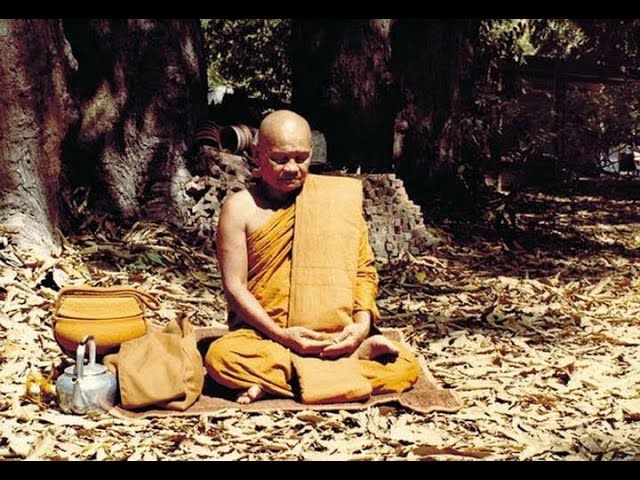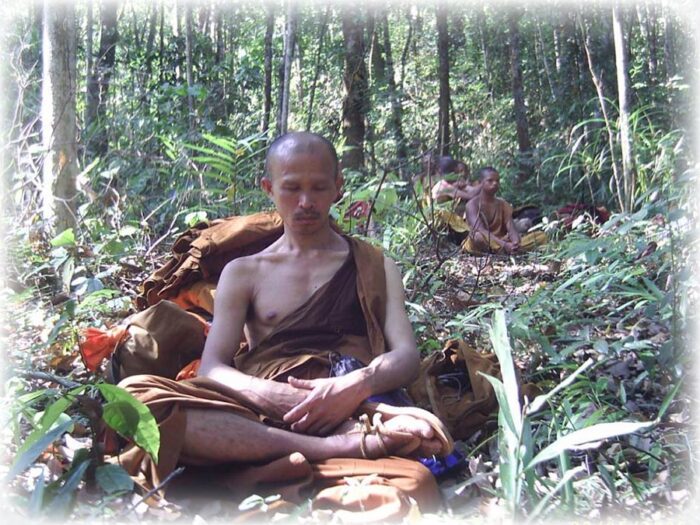What is the Practice of Tudong?
Tudong – Forest Wandering? or More than just That?
Tudong, is the Romanized spelling of the Thai pronunciation for the word ‘Dhutaṅga’ (ธุดงค์). In Thailand, there has become a disambiguation in understanding about what the word means, most people believing it means wandering through the forest in solitary, whereas, wandering is merely one of the 13 parts of practice, focused on never remaining in the same place, to avoid getting attached to comforts.

The 13 Dhutanga practices, often referred to as the “ascetic path,” epitomize the austere disciplines embraced by fervent Buddhist monastics. These practices, as originally established by the Buddha himself, offer a profound framework for cultivating mindfulness, discipline, and detachment from the manifold entanglements of worldly existence. While they are not mandatory for all monastics, those who willingly undertake these practices embark on a journey of transformative self-discovery. Let us now delve into the essence of these practices and their intrinsic significance within Thai Buddhist tradition.

The 13 Dhutanga Practices;
- The renunciation of food after the midday hour. Here, monastics, with steadfast resolve, curtail their daily nourishment to the morning hours. By relinquishing indulgence in post-noon sustenance, practitioners fortify their self-discipline and diminish their attachment to sensory pleasures. This voluntary abstinence allows them to redirect their focus towards spiritual endeavors and transcend the habitual cravings of the physical realm.
- 2. The practice of dwelling amidst the lush solitude of the forest. Enthralled by the majesty of nature, some monastics choose to reside in remote woodlands, far removed from the clamor of human habitation. Amidst these sylvan abodes, they forge a deep-seated connection with the primordial rhythms of existence, their hearts resonating with the serenity and simplicity inherent in the natural world.
- The practice of resting beneath the sheltering embrace of a venerable tree emerges. Under its protective canopy, monks pass the nights in quiet contemplation or restful repose. By embracing this symbiotic alliance with nature, they glean invaluable insights into the transient nature of existence, reinforcing their meditation practice and nurturing a profound appreciation for the impermanence that permeates all facets of life.
- The practice of the utilization of a mere trio of robes. These sacred vestments, carefully fashioned from discarded fabric or donated cloth, embody the virtues of simplicity and detachment from material possessions. Monastics, through this practice, learn to be content with the bare essentials, disentangling themselves from the manifold cravings that ensnare the human psyche.
- The practice of the possession of a single alms bowl holds immense significance in the monastic life. This humble vessel serves as the embodiment of gratitude, humility, and non-attachment to material wealth. Monks traverse the alms rounds with mindful grace, graciously accepting whatever sustenance is offered, devoid of preference or personal desire. This practice instills a deep sense of gratitude and fosters equanimity in the face of life’s vicissitudes.
- The practice of seeking alms for food exemplifies the interdependence and interconnectedness of monastic and lay communities. Relying solely on the benevolence of the laity, monks undertake the noble task of collecting their sustenance. In this reciprocal relationship, they transcend personal boundaries, cultivating humility and gratitude while avoiding attachment to specific individuals or relationships.
- The practice of deliberate avoidance of meal invitations, except those extended by regular benefactors. This practice, rooted in impartiality and non-discrimination, guards against favoritism and cultivates equanimity within the hearts of monastics. By partaking in meals across various households, they nourish their practice of non-attachment, ensuring that bonds of personal connection do not impede their spiritual progress.
- Further along the ascetic path, we encounter the practice of dwelling under the expansive dome of the open sky. Here, monastics relinquish the comfort of shelter, exposing themselves to the elements. This bold undertaking fosters resilience, adaptability, and a profound realization that the inherent peace sought lies not in external circumstances, but in the depths of the human spirit.
- In a gesture that may seem unsettling to the uninitiated, some monks undertake the practice of spending nights within cemetery precincts. Amidst these abodes of the departed, they confront the inescapable truths of impermanence and mortality. Engaging with such contemplation, they unravel the transient nature of all conditioned phenomena, unfurling the petals of detachment from the ephemeral trappings of existence.
- The practice of dwelling at the base of a tree serves as a gentle reminder of life’s evanescent nature. Nestled close to the roots of these majestic arboreal beings, monastics embrace the teachings of simplicity and minimalism. This proximity to the natural world reinforces their understanding of the ephemeral nature of all things and provides fertile ground for the cultivation of deep meditative insight.
- Within these set of thirteen austere practices given by the Buddha, for those who wish to take the ‘high road that arrives faster, we encounter the 11th practice, which is the cultivation of contentment through the mindful employment of a solitary set of three robes, regardless of their state of wear. Monastics gracefully set aside concerns for personal appearance, embracing the inherent beauty of simplicity and fostering non-attachment to vanity. Such noble disregard for worldly preoccupations allows them to redirect their energies toward spiritual pursuits of the highest order.
- Adhering to the Dhutanga path, monastics fashion their robes from discarded cloth, salvaging remnants cast aside by the world. By adopting this resourceful approach, they engender frugality, embodying the essence of non-attachment and reducing their reliance on material possessions. This practice serves as a poignant reminder that spiritual wealth transcends the bounds of material abundance.
- Lastly, the monastic commitment to possess no more than three robes signifies an unwavering commitment to non-attachment. In adhering to this austere guideline, monks demonstrate their profound understanding of the impermanence that permeates all aspects of life. By relinquishing any unnecessary accumulation, they tread lightly upon the earth, their hearts unburdened by excessive possessions.

In essence, the practice of the 13 Dhutanga practices, offer a profound and rigorous framework, for dedicated Buddhist monastics to embark on a transformative journey of spiritual growth. These ascetic disciplines, steeped in mindfulness, simplicity, and non-attachment, serve as powerful catalysts for the realization of liberation from the chains of suffering. It is through the voluntary embrace of these practices, that monastics traverse the path to enlightenment, their hearts buoyed by the boundless potential for awakening that lies within each moment of existence.

Most useful Reference Links and literature; “With Robes and Bowl“
